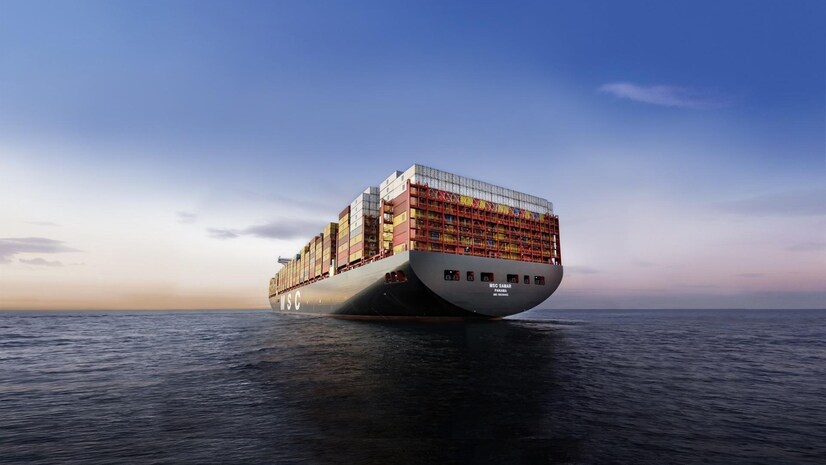09-Apr-2025,06:30 PM In a significant milestone for India’s maritime sector, Vizhinjam International Seaport in Kerala received the world’s largest environment-friendly container ship, MSC Turkiye. This momentous event marks a turning point in India’s logistics and trade infrastructure, putting Vizhinjam on the global map as a hub for mega container vessels. The arrival of the container ship has sparked widespread interest among environmentalists, policymakers, and industry leaders, especially given the ship’s green credentials and the port’s strategic geographical position.
MSC Turkiye is not just notable for its size but also for its advanced sustainability features. Designed to reduce carbon emissions and increase fuel efficiency, the vessel represents a new era in maritime logistics — one that blends scale with sustainability.
Container Ship MSC Turkiye: A Giant in Sustainable Maritime Innovation
The MSC Turkiye is part of the Mediterranean Shipping Company’s (MSC) fleet and boasts impressive statistics that make it a marvel of modern engineering. With a carrying capacity exceeding 24,000 TEUs (Twenty-Foot Equivalent Units), the container ship spans over 400 meters in length and 61 meters in width. It is among the largest of its kind globally.
What makes MSC Turkiye truly groundbreaking is its commitment to sustainability. The vessel is equipped with:
-
Next-gen dual-fuel engines that reduce CO₂ and NOx emissions.
-
Energy-efficient hull designs that optimize speed with minimum drag.
-
Advanced wastewater treatment systems to reduce marine pollution.
-
Smart navigation technology that minimizes fuel consumption.
These innovations align with global efforts to decarbonize shipping, a sector responsible for nearly 3% of worldwide greenhouse gas emissions.
The arrival of such a large and eco-friendly container ship at Vizhinjam Port underscores the region’s readiness to handle mega maritime operations while promoting green shipping practices.
Vizhinjam Port: Emerging Gateway for Global Container Ship Routes
Vizhinjam Port, located near Thiruvananthapuram in Kerala, has steadily developed into one of India’s most promising transshipment ports. Developed by Adani Ports and SEZ Ltd., Vizhinjam’s deep natural harbor — with a draft of over 20 meters — makes it uniquely suited to accommodate ultra-large container ships like the MSC Turkiye.
Its strategic location — just 10 nautical miles from the international East-West shipping route — makes it a cost-effective and time-efficient stopover for global cargo vessels. With the docking of MSC Turkiye, Vizhinjam is now officially recognized as a capable destination for the world’s largest commercial sea vessels.
Port officials celebrated the occasion, calling it a “moment of pride” and a “symbol of India’s future in green port infrastructure.”
container ship : Boost to Kerala’s Economy and India’s Maritime Trade
The successful docking of the massive container ship is more than just a maritime achievement — it’s a strong signal of economic growth for Kerala and India as a whole. With Vizhinjam becoming operational for ultra-large vessels, several key benefits are anticipated:
-
Job Creation: Direct and indirect employment opportunities in logistics, warehousing, transportation, and port management.
-
Export Potential: Kerala-based exporters can reduce transshipment costs by routing their goods directly through Vizhinjam.
-
Revenue Generation: Increased port traffic means higher tax collections, customs duties, and trade volume.
-
Tourism and Trade Infrastructure: With a global container hub at its heart, Kerala can now attract related investments in SEZs and logistics parks.
The state government and Adani Ports have both lauded the arrival of the container ship, citing it as a validation of years of planning, investment, and global coordination.
Global Shipping Industry Applauds India’s Progress
The arrival of MSC Turkiye has not gone unnoticed in international maritime circles. Global media, shipping alliances, and environmental organizations have praised India’s proactive steps in upgrading port infrastructure to accommodate sustainable and large-scale maritime operations.
Experts have noted that the choice of Vizhinjam for this monumental docking was not accidental. The port offers:
-
A naturally deep draft, reducing the need for costly dredging.
-
Proximity to major international sea lanes.
-
Robust connectivity with hinterland rail and road networks.
-
Ambitious environmental management and green port initiatives.
These factors made it an ideal host for the environmentally advanced container ship and a compelling option for future international shipping lines.
Green Ports for a Greener Tomorrow
One of the key messages delivered through the arrival of MSC Turkiye is the need for green transformation in the shipping and logistics sector. With global pressure mounting to reduce carbon emissions and embrace sustainable logistics, both shipping companies and ports must adapt.
Vizhinjam Port has already taken steps in this direction, such as:
-
Installation of solar-powered lighting and renewable energy grids.
-
Wastewater recycling and marine life protection measures.
-
Collaboration with global partners for carbon footprint reduction.
The docking of a green container ship at a port with green goals demonstrates a promising synergy that can serve as a model for the rest of India and the world.
What This Means for India’s Port Modernization Mission
India’s Sagarmala Project and Maritime India Vision 2030 have laid the foundation for massive investment in port modernization, sustainability, and efficiency. The arrival of MSC Turkiye is an early sign of these visions taking shape.
Officials from the Ministry of Ports, Shipping, and Waterways stated that the docking at Vizhinjam shows India’s readiness to handle next-generation container ships that dominate global trade. They also hinted at further plans to link Vizhinjam to inland water transport and regional trade routes.
In the coming years, Vizhinjam Port is expected to reduce India’s dependence on foreign transshipment hubs like Colombo, Singapore, and Jebel Ali — thereby increasing national trade autonomy and reducing costs.
Conclusion: India Charts New Waters in Maritime Sustainability
The arrival of MSC Turkiye at Vizhinjam Port is more than a symbolic event. It signifies India’s growing prominence in the global maritime ecosystem, especially as a country that values both economic growth and environmental sustainability.
As container ships continue to evolve with more eco-friendly technologies and larger capacities, India’s ability to receive and process them efficiently will become a key competitive advantage. Vizhinjam, with its cutting-edge infrastructure and green vision, is set to lead the way.
Whether you’re an environmentalist, a shipping executive, a trader, or just a proud citizen, the arrival of MSC Turkiye gives India many reasons to celebrate — and many more reasons to invest in the future of sustainable maritime development.





